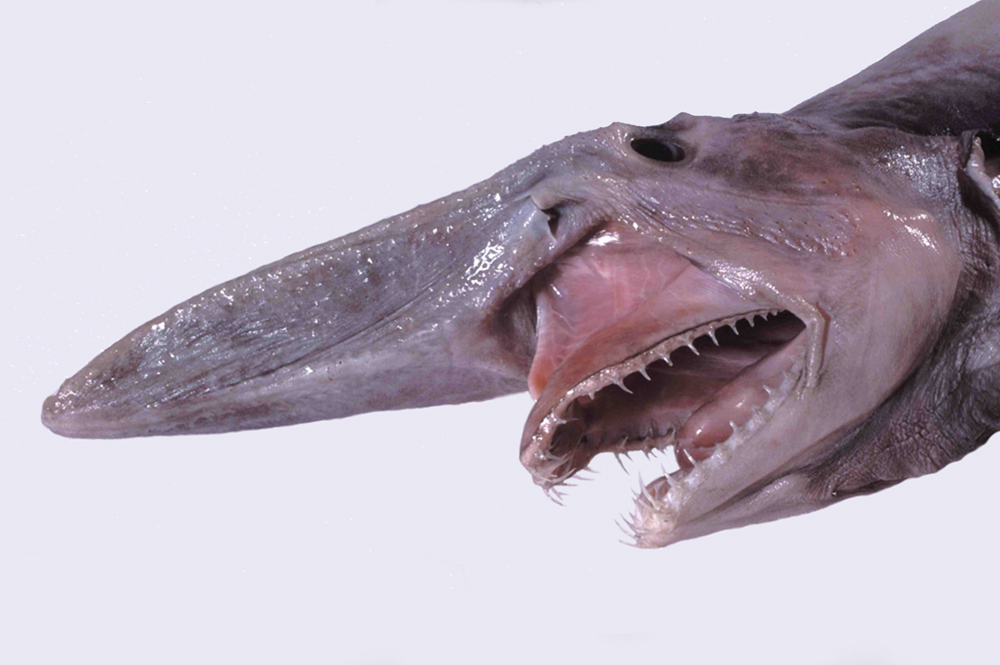The goblin shark is a rarely seen species of deep sea shark. Its population status is in least concern (because of low incidence of capture and its wide distribution) but it is rare as it lives at the bottom of the sea. It is sometimes called a living fossil as its family (Mitsukurinidae) extends back around 125 million years ago. Adults can reach about 10 to 13 ft (3 to 4 m) and can live in depths greater than 330 ft (100 m). Juveniles are smaller and live in shallower water than adults. They live in Submarine canyons, Upper continental slopes and Seamounts around the world. The goblin shark is sllugish in nature because of its flabby body and small fins. It hal a long flat snout and a mouth containing sharp needle like teeth. Its snout, like other sharks, has tiny electrorecepters called Ampullae of Lorenzini that detect electrical pulses emmited by animals. The goblin shark has an eerie habit where it can extend its jaw to catch prey.
- Amazing animals (7)
- Animals on land (10)
- Animals underwater (4)
- Birds (2)
- Dinosaurs (2)
- My favorite animals (5)
- Poems (4)
Sunday, 26 June 2016
Sunday, 19 June 2016
Patagonian Mara
The patagonian mara, (also known as the Patagonian cavy or dillaby) is a medium sized rodent in the species Mara (Dolichotis). It looks somewhat like a cross between a rabbit and a deer. They are related to the Capybara. It is monogamous, meaning that it has only one mate in its life. Their habitat ranges from shrubland to deserts. I never knew about this animal before I researched about it and I thought it was a rare or threatened animal. After researching, however, I found that it was in Near Threatened.
Diet
Patagonian maras are herbivorous animals. They eat herbs and grasses and various vegetables. If they live in the desert, they also include cacti in their diet. Grasses make up for 70% of their diet.
Pictures
Now a video
Saturday, 4 June 2016
Intro to Dinosaurs
As you might have guessed by now, I am starting to blog about Dinosaurs, a subject I know a lot about.
I will do my best to make this topic very interesting and fun to read.
Below will be my guide for the terminology used in my blogs henceforth :-
The two basic divisions of Dinosaurs:-
The two basic divisions are based on the dinosaur's hip joint structure.
I will do my best to make this topic very interesting and fun to read.
Below will be my guide for the terminology used in my blogs henceforth :-
The two basic divisions of Dinosaurs:-
The two basic divisions are based on the dinosaur's hip joint structure.
Saurischia (saw-RIS-kee-a):-
Saurischia is derived from two Greek words:- (Sauros, meaning lizard and ischion meaning hip joint).
As you have just seen, Saurischian means lizard hip. It contains two basic species, Therapods and Sauropods(sauropodomorphs).
- Therapods are carnivourous dinosaurs, such as Tyrannosaurus rex and Spinosaurus.
- Sauropods are dinosaurs with long necks, such as Brachiosaurus and Diplodocus.
Ornithischia is also derived from two Greek words:- (ornitheos, meaning of a bird and ischion, meaning hip joint). The confusing part is that birds are actually members of Saurischia. It contains three basic species, Thyreophera, Pachycephalosauridae, and Hadrosauridae.
- Thyreophera includes armoured dinosaurs like Stegosaurus and Ankylosaurus.
- Pachycephalosauridae includes domeheaded dinosaurs like Pachycephalosaurus and Stygimoloch.
- Hadrosauridae includes duckbilled dinosaurs like Parasaurolophus and Edmontosaurus.
*There are many subfamilies to the species mentioned above and many subfamilies to those too.
Subscribe to:
Comments (Atom)



